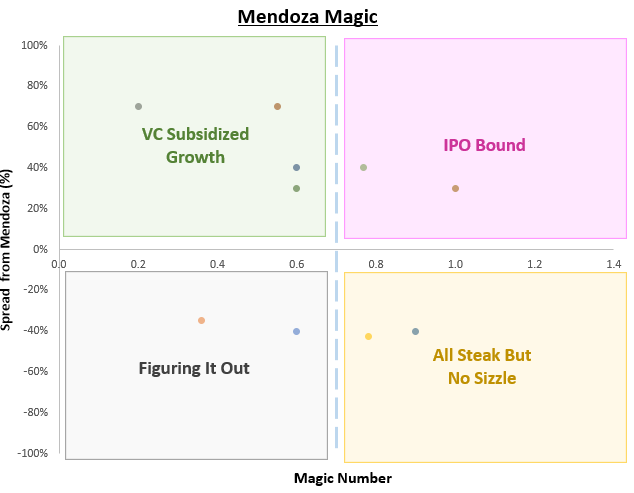How fast should my startup grow for VCs to be interested? The Mendoza Magic Duo
Vertex Holdings02 May 2023“How much should a startup grow?”
*The below article was * [originally published](https://medium.com/@asaf_31000/mendoza-magic-9fd018135384) * by our Vertex Ventures Israel team. *A common question among all of us in tech is what should be the growth target. The intuitive answer is to grow as fast as possible, while keeping the growth efficient. Another factor is cash management viz a viz runway and timing of a possible fund raise. While it is hard and risky to provide a rule of thumb answer, we will try to provide something close to that as a first step to a deeper analysis.
As we searched for meaningful metrics to evaluate the growth and efficiency of our portfolio companies and potential investment opportunities, we came across the SaaStr post that mentioned the Mendoza Line model from a 2019 article by Scale Ventures. 2019 is an interesting time to get perspective from because it might be a good parable for the market condition we are in right now. Of course, it could be claimed we’re heading to even worse market conditions.
The Mendoza Line model, developed by Scale Ventures, helps identify the growth rate at which a SaaS company becomes venture-backable. The model assumes that a good bar for an IPO is to hit $100M ARR with at least 25% growth — while that may seem low by last year standards it could very well be the case where efficient growth is a must. Scale Ventures also uses 82% growth persistence after $10M ARR.
While there are many limitations to this model, we still find it to be a useful tool for helping us and our founders understand where we stand.
The below table shows the expected growth rate based on ARR level according to Mendoza Model:

We analyzed the financial data from our database and plotted it on the Mendoza Line for reference. Below is an example of a few companies. Note that for each company, there are two dots : one for last year’s actual performance and one for the plan for the following year.

However, focusing solely on a company’s growth does not provide us with the complete picture we were seeking. We realized that we were missing an important aspect of the company’s performance — efficiency. To add the efficiency angle to the model, we reverted to the trusted Magic Number method to measure the company’s go-to-market (GTM) motion. We contemplated using the newer Burn Multiple method that was popularized by David Sacks, but found that this model does not do justice to earlier stage companies that still have large R&D departments. We preferred to focus on the efficiency of the GTM team vs. the company as a whole.
The long-term median magic number is 0.7, obviously that number moves higher and lower during the lifetime of a startup.
Examining each metric separately can still make it difficult to determine if a company is performing better than the benchmark. To gain a clear understanding of a company’s growth vs efficiency, we developed (fancy speak to say combined) the Mendoza-Magic Duo.
Mendoza Magic displays a company’s growth and efficiency status simultaneously. To have a clear understanding of the key areas a company should focus on, it is important to consider both growth and efficiency. This includes deciding whether to lower growth and focus on improving GTM motion or to recognize that GTM is working well and, therefore, an option to accelerate growth.
This may remind you of the rule of 40 which fuses growth and profitability but does not take into account different stages of the company.
Referencing the Mendoza Line, we will calculate the difference between a company YoY growth to the expected growth based on Mendoza line, on a basis point level. Then, adding the Magic Number will add the GTM effectiveness aspect.
Below is a plot showing the result of a few of our portfolio companies and investment opportunities (anonymously) we had. We divide the results to four key quadrants:

IPO Bound
Outperforming both on GTM motion as well as expected growth levels.
VC Subsidized Growth
Companies that grow faster than the benchmark, but they still need to improve their GTM efficiency.
All Steak But No Sizzle
Efficient GTM but can consider increasing growth even if it will harm efficiency a bit.
Figuring It Out
Both GTM and growth are below benchmarks, most of these companies have a hard time raising new funding rounds before making significant improvements.
That’s it — we found the above helpful as a means to compare between companies and a step to start the conversation.
Interested in Technopreneurship? Read more here.
Follow us on social media:
/f/233941/1280x720/44735e3895/mendoza-thumb.jpeg)


